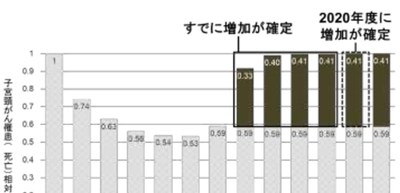
An increased relative risk for future cervical cancer incidence and death calls for swift resumption of active recommendation for HPV vaccination
A group of researchers from Osaka University showed the potential future numbers of cervical cancer incidence and death in Japanese women born after the fiscal year of 2000 due to a decrease in human papillomavirus (HPV) vaccination.
In Japan, some 9,000 women are diagnosed with cervical cancer and 2,000 ~ 3,000 women die from the disease every year. Cervical cancer is the most common HPV-associated cancer among women and it is known that HPV vaccine is a highly effective way to prevent HPV infection. HPV vaccination became a 'national routine immunization' in 2010 and then females aged 12–16 could receive the vaccine for free from April 2013.
However, from the concern for side effects, the Ministry of Health, Labour and Welfare (MHLW) announced a temporary suspension of its recommendation for the vaccine in June of the same year. By the beginning of FY2020, females born in 2000, 2001, 2002 and 2003 reached 12–16, the targeted and subsidized ages for the vaccine.
In this study, the group calculated the relative risk of cervical cancer incidence and death in Japanese women born in and after 2000 and estimated that future incidence and death in females born in FY2000 would be some 17,000 and some 4,000, respectively.
Although females born from 1994 to 1999 were immunized under public subsidies for the vaccine and achieved a 70% vaccination coverage rate for this cohort, following the MHLW’s negative policy change in 2013, the vaccination rate reverted to nearly zero for girls born in 2000 and thereafter. Thus, the negative policy increased the risk of developing cervical cancer.
This group calculated the potential future daily numbers of cervical cancer incidence and death that would be increased by a temporary suspension of its recommendation for the vaccine on condition that the number of yearly vaccinations is evenly distributed across a daily basis.
In FY2020, the large increase of risks to females born in FY2004 amounts to 12.0 females per day (who are at a higher risk for acquiring of cervical cancer in their future) and 3.0 females per day are at risk for future death from that disease in its progressive form.
If the resumption of the recommendation is delayed for one more year, the increased numbers of cervical cancer patients and deaths will be fixed in FY2020 and thereafter.
A national epidemiological survey by the Sofue group of MHLW showed that the "diverse symptoms" were observed even in those who had not received HPV vaccination and a survey in Nagoya reported that there was no significant difference in the 24 reported post-HPV vaccination symptoms between vaccinated and unvaccinated individuals.
This group sincerely asks the government to resume its recommendation for the vaccine as soon as possible to provide an opportunity for immunization to those young women who have already missed their chance at HPV vaccination during the vaccine recommendation hiatus.
Figure 1
Figure 2
Figure 3
The article, “Potential for cervical cancer incidence and death resulting from Japan’s current policy of prolonged suspension of its governmental recommendation of the HPV vaccine,” was published in Scientific Reports at DOI: https://www.nature.com/articles/s41598-020-73106-z.
Related Links
Division of Obstetrics and Gynecology, Osaka University (link in Japanese)
